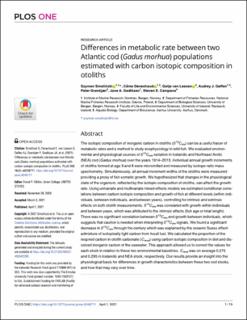| dc.description.abstract | The isotopic composition of inorganic carbon in otoliths (δ13Coto) can be a useful tracer of metabolic rates and a method to study ecophysiology in wild fish. We evaluated environmental and physiological sources of δ13Coto variation in Icelandic and Northeast Arctic (NEA) cod (Gadus morhua) over the years 1914–2013. Individual annual growth increments of otoliths formed at age 3 and 8 were micromilled and measured by isotope-ratio mass spectrometry. Simultaneously, all annual increment widths of the otoliths were measured providing a proxy of fish somatic growth. We hypothesized that changes in the physiological state of the organism, reflected by the isotopic composition of otoliths, can affect the growth rate. Using univariate and multivariate mixed-effects models we estimated conditional correlations between carbon isotopic composition and growth of fish at different levels (within individuals, between individuals, and between years), controlling for intrinsic and extrinsic effects on both otolith measurements. δ13Coto was correlated with growth within individuals and between years, which was attributed to the intrinsic effects (fish age or total length). There was no significant correlation between δ13Coto and growth between individuals, which suggests that caution is needed when interpreting δ13Coto signals. We found a significant decrease in δ13Coto through the century which was explained by the oceanic Suess effect-admixture of isotopically light carbon from fossil fuel. We calculated the proportion of the respired carbon in otolith carbonate (Cresp) using carbon isotopic composition in diet and dissolved inorganic carbon of the seawater. This approach allowed us to correct the values for each stock in relation to these two environmental baselines. Cresp was on average 0.275 and 0.295 in Icelandic and NEA stock, respectively. Our results provide an insight into the physiological basis for differences in growth characteristics between these two cod stocks, and how that may vary over time. | en_US |
